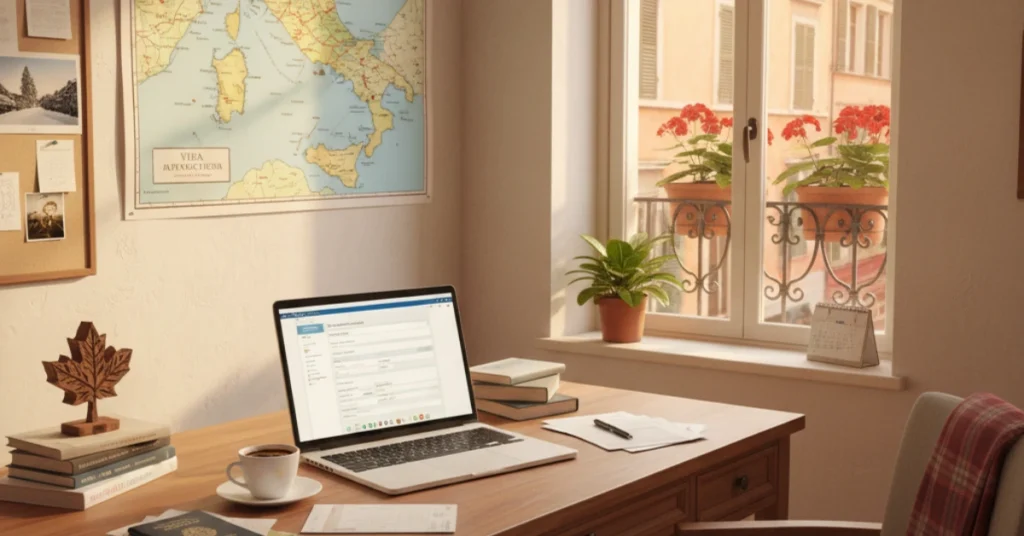If you’re planning to move to Italy from Canada, you’re probably envisioning a life filled with Mediterranean beauty, culture, and slower rhythms—but also wondering what it means financially. Italy isn’t just an attractive lifestyle destination; it offers some notable fiscal advantages for new residents who are relocating with foreign income, pensions, or investment assets.
Table of Contents
ToggleWhy Canadians Are Moving to Italy
In recent years, Italy has become increasingly appealing to Canadians seeking a new chapter abroad. Beyond the lifestyle and climate, Italy’s government has introduced a range of financial incentives designed to attract foreign residents and investors.
One of the most powerful draws is Italy’s special tax regimes for new residents. The country offers favorable rates for retirees, entrepreneurs, and professionals moving from abroad, including a flat-tax regime for high-net-worth individuals and reduced income taxation for those working in Italy under the “impatriate” program.
Moreover, the Canada-Italy Double Taxation Treaty ensures that you won’t be taxed twice on the same income. That means you can enjoy Italy’s fiscal benefits without losing out on your hard-earned income from Canada.
If you’re considering spending your next chapter under Italian skies, these fiscal incentives, combined with a lower cost of living in many regions and world-class healthcare, make the prospect even more attractive.
Visa Options for Canadians in Italy
The first step in moving to Italy from Canada is identifying which visa suits your situation. Italy offers several pathways depending on your purpose, income source, and duration of stay.
For Canadians who wish to retire or live in Italy without working, the Elective Residency Visa is often the best fit. It’s designed for individuals who can demonstrate a stable passive income, such as pensions, savings, or investment returns, sufficient to support themselves without employment. You’ll also need proof of accommodation and private health insurance that meets Italian standards.
If you plan to work in Italy, you’ll need to apply for a work visa, which can take various forms. A standard employment visa is available to those with a job offer from an Italian company, while the self-employment visa serves freelancers, entrepreneurs, or business owners who want to operate independently in Italy.
Young Canadians may also be eligible for a Working Holiday Visa, which allows for a short-term stay of up to twelve months, combining travel with limited work opportunities. This option, however, isn’t suitable for those intending to establish long-term residency.
For anyone seeking a more permanent move, whether for family, business, or lifestyle reasons, a long-stay visa (valid for over 12 months) is essential. Once in Italy, you’ll transition from visa holder to resident, a key step for accessing Italy’s fiscal and healthcare systems.
Establishing Residency and Legal Status
Once you’ve arrived in Italy, your next task is to formalize your presence through Italian bureaucracy, a process that might feel daunting at first but is essential for securing all fiscal benefits.
The first step is registering your address at the local Comune (municipal office). This adds your name to the official population registry, known as the Anagrafe, confirming your residence. Within eight days of arrival, non-EU citizens must also apply for the Permesso di Soggiorno, the residence permit that legalizes their long-term stay.
You’ll then need to obtain an Italian Codice Fiscale, a tax identification number similar to Canada’s SIN. It’s required for opening a bank account, signing contracts, or even getting internet service.
For fiscal purposes, Italy determines tax residence based on presence and life ties. You’re considered a tax resident if you spend more than 183 days in Italy during a calendar year, have your main home or family in Italy, or are registered in the Anagrafe for most of the year. Once you meet any of these criteria, Italy becomes your primary tax jurisdiction, and that’s where the country’s fiscal incentives can really pay off.

Fiscal and Financial Benefits
Italy’s tax system might seem complex, but for Canadians moving there, it can be surprisingly rewarding if you plan properly.
1. Special Tax Regimes
Italy offers several preferential tax regimes aimed at attracting foreign residents. The Flat Tax Regime for high-net-worth individuals allows newcomers to pay a fixed annual amount, typically €100,000, on all foreign income, regardless of amount. This regime can be extended to family members at a lower rate.
For professionals and employees relocating to Italy, the Impatriate Regime offers a significant tax break: 50% of employment income (and up to 90% in southern regions) may be exempt from taxation for five years, with possible extensions.
Retirees can benefit from the 7% Flat Tax Regime, which applies to foreign pension income for those settling in certain southern municipalities. This regime has become particularly popular among Canadians with pension income from Canada Pension Plan, Old Age Security, or private retirement funds.
2. Double Taxation Relief
Thanks to the Canada-Italy Double Taxation Treaty, income earned in one country and taxed there can generally be credited against taxes owed in the other. This ensures you don’t pay taxes twice on the same money. For retirees, professionals, or business owners, this treaty coordination is critical for efficient tax planning.
3. Taxation on Worldwide Income
Once you’re an Italian tax resident, Italy taxes your worldwide income, unless you’re under one of the special regimes. That includes income from Canadian sources such as rent, dividends, or capital gains. However, these can often be offset through the treaty, deductions, or exemptions.
4. Wealth and Asset Reporting
Italian tax residents must declare foreign assets, including bank accounts and investments, using the “Quadro RW” section of the Italian tax return. Certain foreign assets may also be subject to small annual levies: the IVIE for real estate and IVAFE for financial holdings. These rates are typically modest but should be factored into your overall financial plan.
Financial Life After the Move
Once you’ve settled in Italy, your day-to-day financial life will look different, not necessarily more difficult, but certainly more structured.
You’ll need an Italian bank account for most transactions. Opening one requires your Codice Fiscale and proof of residence, and it’s essential for paying bills, receiving salary or pension income, and making tax payments.
For healthcare, many newcomers rely initially on private health insurance (as required for most visas), but once you become a legal resident, you can register with Italy’s public healthcare system (Servizio Sanitario Nazionale). The system provides broad coverage at minimal cost, though private plans can supplement faster or English-language care.
When it comes to living costs, Italy offers good value compared to major Canadian cities, though regional variation is large. Northern cities like Milan and Bologna are costlier, while southern towns and rural areas remain affordable. Groceries, public transportation, and healthcare are generally cheaper than in Canada, while utilities and bureaucracy-related costs can be higher.
You should also plan for administrative expenses, such as visa renewals, translation of Canadian documents, legal registrations, and professional accounting assistance. These may seem small individually, but they can add up during the first year of your move.
How Your Income and Assets Are Treated
The treatment of your income and assets depends primarily on whether you are considered a tax resident.
If you spend more than half the year in Italy and meet residency conditions, your global income becomes taxable under Italian law. The tax brackets are progressive, ranging from roughly 23% for lower incomes to 43% for the highest earners. Regional and municipal surcharges may apply.
However, as a Canadian relocating under one of Italy’s preferential regimes, your situation can be far more favorable. Under the impatriate regime, only half of your employment income may be taxable. Under the flat-tax regime, your foreign income can be capped at the fixed amount regardless of its actual size, an enormous advantage for high-earning professionals or retirees with global investments.
Meanwhile, the 7% flat tax available in southern regions is one of Europe’s most attractive incentives for retirees. It can drastically reduce tax burdens on foreign pensions and income for up to ten years.
As for your Canadian investments, you can generally maintain them after relocating, though they must be declared to Italian authorities. The Canada-Italy treaty allows for coordination between the two systems, so Canadian-source income isn’t taxed twice. That said, working with a tax advisor who understands both jurisdictions is highly recommended to avoid compliance issues.
Making the Move Financially Smart
Italy’s mix of lifestyle and fiscal incentives can deliver powerful rewards, especially when paired with careful financial planning. From visa selection and residency registration to tax optimization and asset reporting, each step builds on the last.
With preparation, patience, and the right professional guidance, your move from Canada to Italy can be both a lifestyle upgrade and a financial win. After all, few countries let you sip espresso under Renaissance ceilings while paying less tax on your Canadian pension.
Would you like to read more about similar subjects? Take a look at our related articles here: Moving to Italy from Australia, Residence Permit for Cohabitation and Italian Golden Visa.
Quiz: Moving to Italy from Canada
1. What is one of the main reasons Canadians are attracted to move to Italy?
High salariesFavorable tax regimes and lifestyle benefits
Free housing for foreigners
2. What treaty helps prevent Canadians from being taxed twice on the same income?
The NAFTA AgreementThe Canada-Italy Double Taxation Treaty
The EU-Canada Fiscal Agreement
3. Which visa is best for Canadians who want to retire in Italy without working?
Student VisaElective Residency Visa
Work Visa
4. What document serves as Italy’s tax identification number?
Codice FiscalePermesso di Soggiorno
Tessera Sanitaria
5. How many days must you spend in Italy to be considered a tax resident?
More than 90 daysMore than 183 days
More than 300 days
6. What does the Impatriate Regime offer to professionals moving to Italy?
50–90% exemption on employment incomeFree housing assistance
Tax-free business profits
7. What is the 7% Flat Tax Regime mainly designed for?
Retirees in specific southern municipalitiesTech entrepreneurs in Milan
Freelancers working remotely
8. What must Italian tax residents declare on their tax return using the “Quadro RW” section?
Only Italian incomeAll foreign assets and investments
Real estate within Italy
9. Which healthcare option becomes available once you become a legal resident of Italy?
Servizio Sanitario Nazionale (public healthcare system)Only private insurance
Canadian healthcare extension
10. Under the Flat Tax Regime for high-net-worth individuals, what do newcomers pay?
A fixed annual amount (around €100,000) on all foreign incomeRegular progressive income tax rates
No taxes at all



